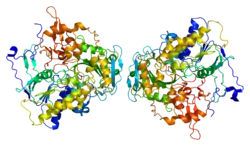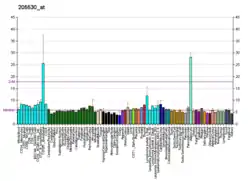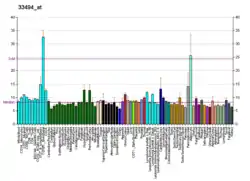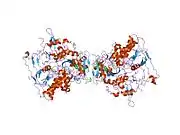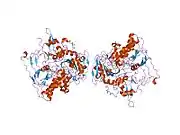ETFDH
Electron transfer flavoprotein-ubiquinone oxidoreductase, mitochondrial is an enzyme that in humans is encoded by the ETFDH gene. This gene encodes a component of the electron-transfer system in mitochondria and is essential for electron transfer from a number of mitochondrial flavin-containing dehydrogenases to the main respiratory chain.[5]
Function
Electron-transferring-flavoprotein dehydrogenase in the inner mitochondrial membrane accepts electrons from electron-transfer flavoprotein which is located in the mitochondrial matrix and reduces ubiquinone in the mitochondrial membrane. Deficiency in electron-transferring-flavoprotein dehydrogenase have been demonstrated in some patients with type II glutaric aciduria.[5]
Structure
The ETFDH gene is located on the q arm of chromosome 4 in position 32.1 and has 13 exons spanning 36,613 base pairs.[6][7] The protein is synthesized as a 67-kDa precursor which is targeted to mitochondria and processed in a single step to a 64-kDa mature form located in the mitochondrial membrane.[5] This 64-kDA mature form is a monomer integrated into the mitochondrial inner membrane, containing a 4Fe-4S cluster and 1 molecule of FAD.[7]
Function
This enzyme, along with electron transfer flavoprotein (ETF), is required for electron transfer from more than 9 mitochondrial flavin-containing dehydrogenases to the main respiratory chains.[7] It accepts electrons from ETF and reduces ubiquinone.[8][9]
Clinical Significance
Mutations in the ETFDH can cause glutaric aciduria 2C (GA2C), an autosomal recessively inherited disorder of fatty acid, amino acid, and choline metabolism. It is characterized by multiple acyl-CoA dehydrogenase deficiencies resulting in large excretion not only of glutaric acid, but also of lactic, ethylmalonic, butyric, isobutyric, 2-methyl-butyric, and isovaleric acids.[8][9]
A c.250G>A (p.Ala84Thr) mutation, the most common mutation in the ETFDH gene, causes increased production of reactive oxygen species (ROS) and shortened neurites in cells expressing this mutant compared to wild type cells. Suberic acid, an accumulated intermediate metabolite in dehydrogenase deficiency, can significantly impair neurite outgrowth in NSC34 cells. This shortening of neurites can be restored by riboflavin, carnitine, or Coenzyme Q10 supplements.[10]
Interactions
The encoded protein interacts with MYH7B, LINC00174, LINC00574, Homeobox protein goosecoid-2, AIRE, OTX1, Keratin-associated protein 13-2, Keratin-associated protein 11-1, TRIM69, Zinc finger protein 581, and COX6B1.[11]
References
- GRCh38: Ensembl release 89: ENSG00000171503 - Ensembl, May 2017
- GRCm38: Ensembl release 89: ENSMUSG00000027809 - Ensembl, May 2017
- "Human PubMed Reference:". National Center for Biotechnology Information, U.S. National Library of Medicine.
- "Mouse PubMed Reference:". National Center for Biotechnology Information, U.S. National Library of Medicine.
- "Entrez Gene: ETFDH electron-transferring-flavoprotein dehydrogenase".
- Olsen RK, Andresen BS, Christensen E, Bross P, Skovby F, Gregersen N (July 2003). "Clear relationship between ETF/ETFDH genotype and phenotype in patients with multiple acyl-CoA dehydrogenation deficiency". Human Mutation. 22 (1): 12–23. doi:10.1002/humu.10226. PMID 12815589. S2CID 24730356.
- Online Mendelian Inheritance in Man (OMIM): Electron transfer flavoprotein dehydrogenase; ETFDH - 231675
- "ETFDH - Electron transfer flavoprotein-ubiquinone oxidoreductase, mitochondrial precursor - Homo sapiens (Human) - STXBP1 gene & protein". www.uniprot.org. Retrieved 2018-08-29.
 This article incorporates text available under the CC BY 4.0 license.
This article incorporates text available under the CC BY 4.0 license. - "UniProt: the universal protein knowledgebase". Nucleic Acids Research. 45 (D1): D158–D169. January 2017. doi:10.1093/nar/gkw1099. PMC 5210571. PMID 27899622.
- Liang WC, Lin YF, Liu TY, Chang SC, Chen BH, Nishino I, Jong YJ (September 2017). "Neurite growth could be impaired by ETFDH mutation but restored by mitochondrial cofactors". Muscle & Nerve. 56 (3): 479–485. doi:10.1002/mus.25501. PMID 27935074. S2CID 38848222.
- IntAct. "ETFDH interactions". www.ebi.ac.uk. Retrieved 2018-09-05.
Further reading
- Wolfe LA, He M, Vockley J, Payne N, Rhead W, Hoppel C, Spector E, Gernert K, Gibson KM (December 2010). "Novel ETF dehydrogenase mutations in a patient with mild glutaric aciduria type II and complex II-III deficiency in liver and muscle". Journal of Inherited Metabolic Disease. 33 Suppl 3: S481-7. doi:10.1007/s10545-010-9246-8. PMC 3970109. PMID 21088898.
- Wen B, Li D, Li W, Zhao Y, Yan C (June 2015). "Multiple acyl-CoA dehydrogenation deficiency as decreased acyl-carnitine profile in serum". Neurological Sciences. 36 (6): 853–9. doi:10.1007/s10072-015-2197-y. PMID 25827849. S2CID 9449668.
- Whitaker CH, Felice KJ, Silvers D, Wu Q (August 2015). "Fulminant lipid storage myopathy due to multiple acyl-coenzyme a dehydrogenase deficiency". Muscle & Nerve. 52 (2): 289–93. doi:10.1002/mus.24552. PMID 25556768. S2CID 31711349.
- Olsen RK, Olpin SE, Andresen BS, Miedzybrodzka ZH, Pourfarzam M, Merinero B, Frerman FE, Beresford MW, Dean JC, Cornelius N, Andersen O, Oldfors A, Holme E, Gregersen N, Turnbull DM, Morris AA (August 2007). "ETFDH mutations as a major cause of riboflavin-responsive multiple acyl-CoA dehydrogenation deficiency". Brain. 130 (Pt 8): 2045–54. doi:10.1093/brain/awm135. PMID 17584774.
- Gempel K, Topaloglu H, Talim B, Schneiderat P, Schoser BG, Hans VH, Pálmafy B, Kale G, Tokatli A, Quinzii C, Hirano M, Naini A, DiMauro S, Prokisch H, Lochmüller H, Horvath R (August 2007). "The myopathic form of coenzyme Q10 deficiency is caused by mutations in the electron-transferring-flavoprotein dehydrogenase (ETFDH) gene". Brain. 130 (Pt 8): 2037–44. doi:10.1093/brain/awm054. PMC 4345103. PMID 17412732.
- Olsen RK, Andresen BS, Christensen E, Bross P, Skovby F, Gregersen N (July 2003). "Clear relationship between ETF/ETFDH genotype and phenotype in patients with multiple acyl-CoA dehydrogenation deficiency". Human Mutation. 22 (1): 12–23. doi:10.1002/humu.10226. PMID 12815589. S2CID 24730356.
- Goodman SI, Binard RJ, Woontner MR, Frerman FE (2003). "Glutaric acidemia type II: gene structure and mutations of the electron transfer flavoprotein:ubiquinone oxidoreductase (ETF:QO) gene". Molecular Genetics and Metabolism. 77 (1–2): 86–90. doi:10.1016/S1096-7192(02)00138-5. PMID 12359134.
- Simkovic M, Degala GD, Eaton SS, Frerman FE (June 2002). "Expression of human electron transfer flavoprotein-ubiquinone oxidoreductase from a baculovirus vector: kinetic and spectral characterization of the human protein". The Biochemical Journal. 364 (Pt 3): 659–67. doi:10.1042/BJ20020042. PMC 1222614. PMID 12049629.
- White RA, Dowler LL, Angeloni SV, Koeller DM (April 1996). "Assignment of Etfdh, Etfb, and Etfa to chromosomes 3, 7, and 13: the mouse homologs of genes responsible for glutaric acidemia type II in human". Genomics. 33 (1): 131–4. doi:10.1006/geno.1996.0170. PMID 8617498.
- Goodman SI, Axtell KM, Bindoff LA, Beard SE, Gill RE, Frerman FE (January 1994). "Molecular cloning and expression of a cDNA encoding human electron transfer flavoprotein-ubiquinone oxidoreductase". European Journal of Biochemistry. 219 (1–2): 277–86. doi:10.1111/j.1432-1033.1994.tb19939.x. PMID 8306995.
This article incorporates text from the United States National Library of Medicine, which is in the public domain.
